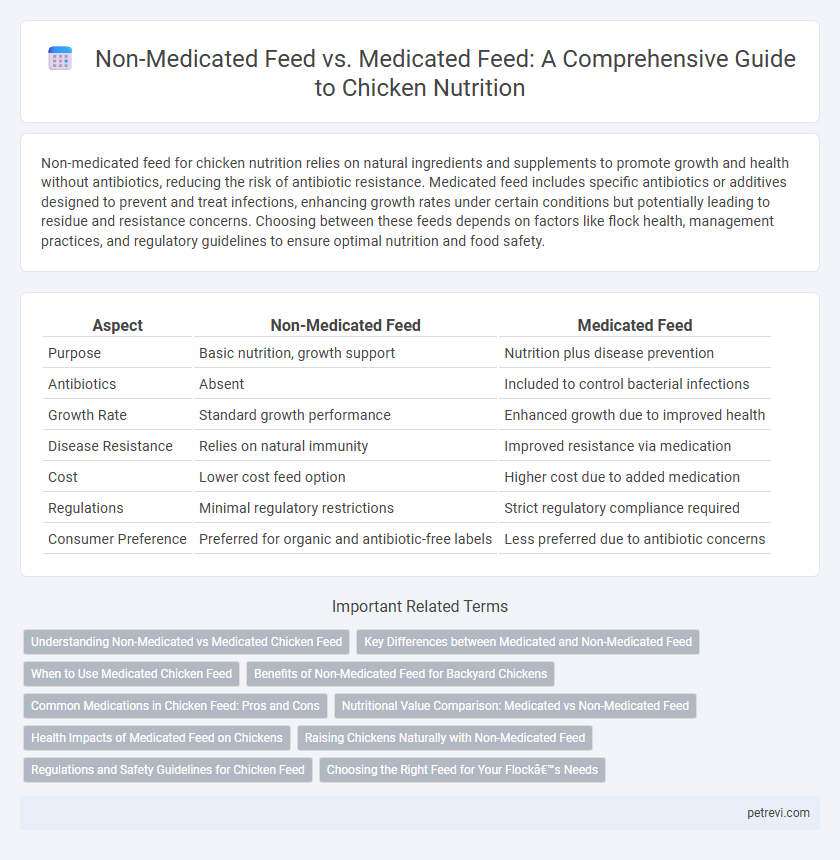Non-medicated feed for chicken nutrition relies on natural ingredients and supplements to promote growth and health without antibiotics, reducing the risk of antibiotic resistance. Medicated feed includes specific antibiotics or additives designed to prevent and treat infections, enhancing growth rates under certain conditions but potentially leading to residue and resistance concerns. Choosing between these feeds depends on factors like flock health, management practices, and regulatory guidelines to ensure optimal nutrition and food safety.
Table of Comparison
| Aspect | Non-Medicated Feed | Medicated Feed |
|---|---|---|
| Purpose | Basic nutrition, growth support | Nutrition plus disease prevention |
| Antibiotics | Absent | Included to control bacterial infections |
| Growth Rate | Standard growth performance | Enhanced growth due to improved health |
| Disease Resistance | Relies on natural immunity | Improved resistance via medication |
| Cost | Lower cost feed option | Higher cost due to added medication |
| Regulations | Minimal regulatory restrictions | Strict regulatory compliance required |
| Consumer Preference | Preferred for organic and antibiotic-free labels | Less preferred due to antibiotic concerns |
Understanding Non-Medicated vs Medicated Chicken Feed
Non-medicated chicken feed provides essential nutrients without antibiotics, supporting natural growth and immune function while reducing the risk of antibiotic resistance and residues in meat. Medicated feed contains antibiotics or additives designed to prevent or treat specific diseases, promoting faster recovery and improved flock health in disease-prone environments. Choosing between non-medicated and medicated feed depends on flock health status, biosecurity measures, and regulatory guidelines for antibiotic use in poultry nutrition.
Key Differences between Medicated and Non-Medicated Feed
Non-medicated feed for chickens contains basic nutrients without added antibiotics, promoting natural growth and reducing antibiotic resistance risks. Medicated feed includes specific antimicrobial agents aimed at preventing or treating diseases like coccidiosis, enhancing flock health and performance. Choosing between these feeds depends on disease management strategies, regulatory guidelines, and production goals in poultry nutrition.
When to Use Medicated Chicken Feed
Medicated chicken feed is primarily used during periods of high disease risk or when birds show early signs of infection, helping to prevent the spread of common poultry illnesses like coccidiosis. Non-medicated feed supports routine growth and nutritional needs without antibiotics or anticoccidials, ideal for healthy flocks under strict biosecurity. Implementing medicated feed at critical stages, such as brooding or environmental stress, ensures optimal flock health and productivity while minimizing medicinal residues in meat.
Benefits of Non-Medicated Feed for Backyard Chickens
Non-medicated feed for backyard chickens supports natural immunity by avoiding antibiotics, reducing the risk of antibiotic resistance and promoting healthier gut flora. This feed type also ensures that eggs and meat remain free from chemical residues, aligning with organic and natural farming preferences. Using non-medicated feed encourages sustainable backyard chicken raising, fostering improved overall bird well-being and nutrition.
Common Medications in Chicken Feed: Pros and Cons
Non-medicated feed supports natural growth and reduces the risk of antibiotic resistance, while medicated feed often contains antibiotics like ionophores and coccidiostats to control diseases such as coccidiosis and necrotic enteritis. Common medications like bacitracin and salinomycin enhance feed efficiency and disease prevention but may raise concerns about drug residues and resistance. Choosing between non-medicated and medicated feed depends on farm management practices, disease prevalence, and regulatory guidelines.
Nutritional Value Comparison: Medicated vs Non-Medicated Feed
Medicated feed for chickens often contains added antibiotics or coccidiostats, targeting disease prevention while maintaining essential nutrients like proteins, vitamins, and minerals. Non-medicated feed emphasizes natural growth through balanced ingredients such as grains, legumes, and fortified vitamins, ensuring adequate nutritional value without drug residues. Both feed types provide core nutrition required for growth, but medicated feed offers added health protection at potential risks of antibiotic resistance.
Health Impacts of Medicated Feed on Chickens
Medicated feed for chickens contains antibiotics or anticoccidials designed to prevent disease and promote growth, which can reduce mortality and improve overall flock health when used properly. However, excessive or inappropriate use may lead to antibiotic resistance, disrupting gut microbiota and increasing the risk of resistant bacterial strains. Non-medicated feed, while free from these risks, requires rigorous biosecurity and management practices to maintain optimal chicken health and prevent disease outbreaks.
Raising Chickens Naturally with Non-Medicated Feed
Raising chickens naturally with non-medicated feed supports organic growth by avoiding antibiotics and synthetic additives, promoting a healthier gut microbiome and reducing antibiotic resistance risks. Non-medicated feed emphasizes balanced nutrition from natural grains, seeds, and supplements, enhancing immunity and overall bird vitality. Compared to medicated feed, this approach fosters sustainable poultry farming practices aligned with consumer demand for chemical-free, high-quality chicken products.
Regulations and Safety Guidelines for Chicken Feed
Regulations governing medicated and non-medicated chicken feed emphasize strict safety guidelines to prevent antibiotic residues in poultry products and ensure consumer health. Non-medicated feed is subject to quality standards that prohibit unapproved drug additives, promoting natural growth and preventing antimicrobial resistance. Medicated feed requires precise labeling, veterinarian oversight, and adherence to withdrawal periods to guarantee safe consumption and compliance with food safety laws.
Choosing the Right Feed for Your Flock’s Needs
Non-medicated feed supports natural growth and immunity in chickens without the risk of antibiotic resistance, making it ideal for small-scale or organic farms. Medicated feed contains specific antibiotics to prevent or treat bacterial infections, suitable for flocks facing health challenges or high disease pressure. Choosing the right feed depends on flock health status, management practices, and regulatory guidelines to optimize nutrition and protect poultry welfare.
Non-medicated feed vs Medicated feed for Chicken Nutrition Infographic

 petrevi.com
petrevi.com